|
| OO Scale | N Scale | G Scale | Z Scale | HO Scale | Slot Cars & R⁄C |
| |||||||
|
|||||||
| Home Page | |||||||
| BUY GIFT VOUCHERS | |||||||
| Products | |||||||
| Latest News | |||||||
| RIGHT LINES | |||||||
| Bargains | |||||||
| Downloads | |||||||
| Events | |||||||
| Careers & Jobs | |||||||
| Carriage Services | |||||||
| About Us | |||||||
| Contact Us | |||||||
| Pay Us A Visit | |||||||
| Meet The Staff | |||||||
| Links | |||||||
| SHOPPING BASKET |
Your shopping basket is empty. To add an item, click the "Buy" button
| YOUR ACCOUNT | ||
|
||||
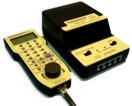 |
||||
| Prodigy Advance Digital System |
||||
| Cased Controllers |
||||
| Panel Mount Controllers |
||||
| Walkabout Controllers |
||||
| Modules & Transformers |
||||
| Scenics & Accessories |
||||
| Wiring & Electrical Components |
||||
| Tiny Signs | ||||
| Tools | ||||
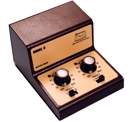 |
||||
| RECENTLY VIEWED |
| MODELSTRIP - Use GM08 |
| O Scale | Wargaming | Architectural | Narrow Gauge | Tools+ | ||
It's a Different World Over There...
The Railways of Russia and the Baltic States
RIGHT LINES reader TONY OLSSON gives us a guide as to what is available for these interesting railways.

Many tourists, railway enthusiasts and railway modellers in Britain have little idea of the joys of Estonia, Latvia and Lithuania and their unique railways. Fortunately companies such as Roco, Fleischmann, Märklin, Piko and Trix make models of the iconic locos and passenger trains, and they can be obtained from Gaugemaster (thanks for the plug! - Ed).
During WW2, the Baltic States were occupied by the USSR, and remained Soviet Socialist Republics until they gained independence from Russia in 1991. Consequently, for most of the 20th Century, their trains were the same as those built and used in the USSR.
All three Baltic States are modernising their train fleets, but because of the rugged nature of the Soviet-built machines, many are still in use, some even being rebuilt with new bodywork and diesel engines on the original underframe and bogies.
Trains in Russia and the Baltic States are BIG, with a gauge of 1520mm (reduced from 1524mm or 5ft in the 1960s) with a loading gauge considerably bigger than in Britain. As in continental Europe, double deck passenger trains are used on some lines. Traditionally the Baltic States were east/west transit routes for very long and heavy freight trains moving coal, oil and grain from Russia to ports on the Baltic Sea. Sadly, models of the huge and impressive steam freight locomotives such as the L Class 2-10-0 which dwarfs our equivalent Class 9F are not produced by the trade, but the modern diesel replacements, the M62 and the double unit 2M62 and some shunting locomotives are made by Roco. Smaller firms make other locomotives not stocked by Gaugemaster.
Various M62s are available in different liveries – standard gauge versions were exported to many countries under Soviet control, and had screw couplings and buffers, whereas locos for use in the Soviet Union and the Baltic States had no buffers and were fitted with large knuckle couplings. Roco produce appropriate versions, the locos for use on ex-Soviet layouts are usually in Soviet green. Twenty-seven years after independence, they are still being repainted in Soviet livery in Lithuania, where a shed Manager explained to me “We have the paint, we know how to apply it, so why change?” The livery for new and rebuilt locomotives in Lithuania is red.
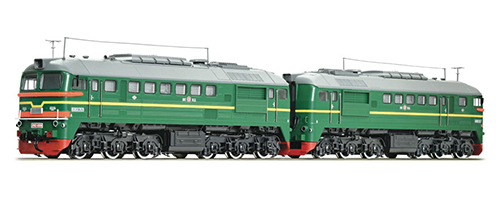
Roco 2M62 Locomotive.
Roco produce the 2M62 in HO Scale. Both units are powered, so only layout size limitations (and cost) would prevent scale length freight trains being hauled. These locomotives are used almost exclusively for freight. Roco’s single unit M62 in Soviet green is currently not available, though alternative versions in other liveries and with buffers are available.
Passenger Trains
TEP70 and TEP75 diesels are used on long-distance passenger trains from the Baltic States’ capitals and Kaliningrad to St Petersburg and Moscow. There are no rail services between the Baltic States’ capitals. Within Russia, versions of the Siemens Velaro ICE3 trains known as Sapsan - Peregrine Falcon - built to the Russian loading gauge, are replacing locomotive-hauled passenger trains. Piko have made models of this train.

Internal passenger trains within the Baltic States are either DMUs or EMUs, many of Soviet origin, or modern units bought from European train makers. Basically Estonia has gone electric with only a few lines operating DMUs. Latvia has dragged its brakes over modernising its trains, but the decision has been made to go electric. Lithuania has been much more progressive, buying Central European electric and diesel passenger trains and updating tracks for high speed trains. The M62s and 2M62s are being replaced with the ER20CF, a large Co-Co version of Siemens’ EuroRunner diesel which can be used for freight and passenger trains. Sadly none of these trains are available in model form.
Shunting Locomotives
Like the locomotives for main line trains, these are big. More like a Class 20 than a Class 08. There are two main shunting locomotives; the ChME3 and the TEM2 and variants. These were built in huge quantities in the Soviet Union from the 1960s, and many thousands are still in use. Piko and Roco produce the ChME3 in Russian and other liveries. Factories in Lithuania and Russia are modernising these locos by installing Caterpillar engines and fitting new bodywork to the chassis and bogies. They are known as TEM TMH, but sadly models are no longer made.
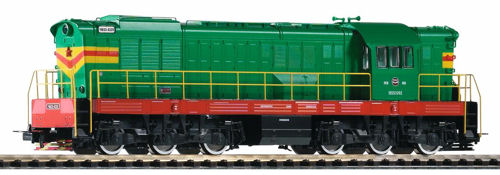
The exception to the big locos theme is the TGK2-M, a small diesel shunter used mainly on factory layouts. Piko models this loco in RZD livery. Small numbers are used in the Baltic States.
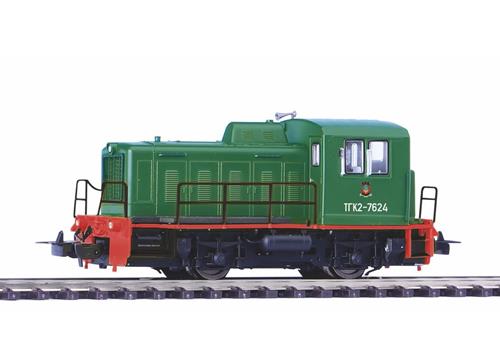
A note on NEM Couplers
In order to fit couplers to specified standards, the couplings are much lower than they are on the real locomotives as can be seen on the above model, where the coupling should be between the lamps. Hence liberties have been taken with the lower portions of the ends of the locomotives and other rolling stock. Revised body panels are usually supplied for use where the models are intended for display rather than operation. The problem is that traditionally, model train couplings are attached to the front of the bogies instead of the ends of the vehicles as in full sized practice. Skilled modellers might be able to modify the models to eliminate the unsightly appearance of couplings hanging down below the bodywork which is a problem even in British outline models as illustrated by Heljan’s Kestrel model below.
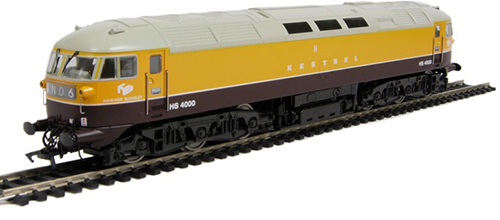
Heljan Hawker Siddeley Brush HS 4000 Kestrel prototype Diesel-Electric Locomotive.
Not a Soviet locomotive, but after British Rail declined to buy any of these speculative locomotives produced by Hawker Siddeley, it was virtually given away to the Soviet Union where it was used on the Tallinn to Leningrad line, and as a guide in the design of their TEP 70 and TEP 75 passenger locomotives.
The locomotives chosen for this review are based on those available from Gaugemaster.
|
We are always looking to make improvements to our website to try and improve the quality of your visit. We would welcome your feedback and suggestions, so please do not hesitate to e-mail our webmaster with your comments. Alternatively call us on 01903 884488.
Home Cookies Privacy Statement Terms & Conditions Site Map Site Guide
WEEE Regulations Glossary Careers & Jobs
Tel – +44 (0) 1903 884488 Fax – +44 (0) 1903 884377 E-Mail us – click here
Gaugemaster.com is a trading name of Gaugemaster Controls Ltd.
Registered in England No. 2714470, Registered office:
Gaugemaster House, Ford Road
Arundel, West Sussex, BN18 0BN, United Kingdom
VAT Reg. No. 587 8089 71
Copyright © 2003-2014 Gaugemaster Controls Ltd. All Rights Reserved.
















